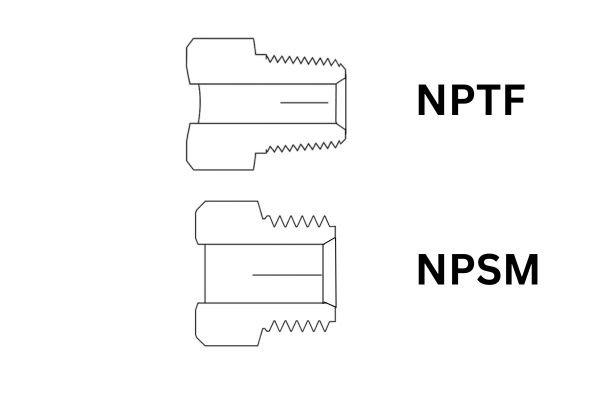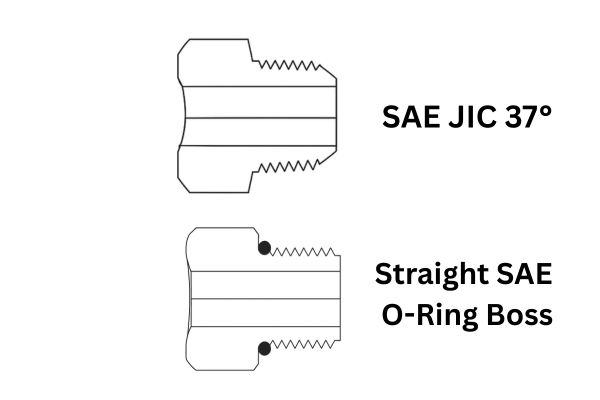Hydraulic hose fittings are crucial components in fluid power systems, ensuring efficient and safe fluid flow. However, misidentifying these fittings can lead to system failures, costly downtime, and safety hazards. This guide aims to help you avoid common mistakes in hydraulic hose fitting identification by providing a step-by-step process and detailed insights into various fitting types and standards.
One of the most prevalent mistakes in hydraulic hose fitting identification is confusing permanent (crimped) and reusable fittings. Permanent fittings are crimped onto the hose using a specialized crimping tool, making them non-reusable once removed. These fittings are favored for their reliability and strength, commonly used in high-pressure applications where a secure, leak-free connection is critical.
Reusable fittings, conversely, can be detached and reattached using basic hand tools like a wrench and vise. They are designed for flexibility, allowing for hose replacement without discarding the fitting. Reusable fittings are typically found in lower-pressure environments or situations where frequent disassembly is necessary.
To avoid misidentification:
Thread types are another common source of confusion. Hydraulic systems use various thread standards, including National Pipe Tapered (NPT), British Standard Pipe (BSP), metric, and others. Each thread type has unique characteristics and applications:
To avoid mistakes:
Hydraulic fittings employ various sealing methods to prevent leaks and ensure a secure connection. Common sealing methods include O-rings, mated angles, and threaded seals. Misidentifying these methods can lead to leaks and system inefficiencies:
To properly identify the sealing method:
Each hydraulic fitting has specific design features, such as nose seats, seat angles, and fitting terminations, which must be accurately identified to ensure compatibility:
To avoid errors:

Proper identification of hydraulic hose fittings begins with determining whether the fitting is reusable or permanent. Each type has distinct characteristics that can be identified through careful examination and the use of specific tools.
Identification:
Reusable fittings are designed to be detached and reattached without damaging the hose or fitting itself. They typically feature a threaded nut that can be manually tightened or loosened using basic hand tools such as a wrench and a vise. When examining a reusable fitting, look for:
Identification:
Permanent fittings, also known as crimped fittings, are attached to the hose using a crimping tool that deforms the fitting to secure it in place permanently. These fittings cannot be reused once removed without being cut off. Key identifiers include:
Tools Used for Identification:
By closely examining the fittings using the aforementioned tools and methods, you can accurately determine whether a hydraulic hose fitting is reusable or permanent. This step is crucial for ensuring that the correct fitting type is used in each specific application, maintaining the integrity and safety of the hydraulic system.
Properly identifying the fitting ends and port connections is essential to ensure compatibility and prevent leaks in hydraulic systems. Different standards and thread types are used globally, and recognizing these is key to accurate identification.
Description:
NPT threads are tapered, meaning the thread diameter decreases along the length. This tapering allows the threads to deform slightly when tightened, creating a tight, leak-resistant seal.
Identification Tips:

Description:
Similar to NPT, BSPT threads are also tapered. However, they have different thread angles and pitches.
Identification Tips:
Description:
SAE standards encompass various thread types and fitting styles used in hydraulic systems, such as JIC 37° flare, ORB (O-Ring Boss), and ORFS (O-Ring Face Seal).
Identification Tips:

Description:
ISO standards include metric threads and fittings used globally, ensuring compatibility across different regions and equipment manufacturers.
Identification Tips:
Identifying the sealing method used in hydraulic hose fittings is essential for ensuring leak-free connections and maintaining system integrity. Here are the common sealing methods and their key characteristics:
O-Ring Boss (ORB):
Description:
ORB fittings use a straight thread with an O-ring seated in the male part of the fitting. When the fitting is tightened, the O-ring compresses against the flat surface inside the female port, creating a leak-tight seal.
Identification Tips:
Flat Face O-Ring Seal (ORFS):
Description:
ORFS fittings feature a flat face with an O-ring that seals when compressed against a flat mating surface. This design provides excellent leak prevention, even under high pressure.
Identification Tips:
O-Ring Flange:
Description:
This sealing method utilizes an O-ring placed in a groove on the flange face. The O-ring is compressed between the flange and the mating surface, ensuring a secure seal.
Identification Tips:

SAE 45° Flare:
Description:
These fittings seal through a 45° angled flare on the male and female parts. When tightened, the flared surfaces compress against each other, creating a seal.
Identification Tips:
JIC 37° Flare:
Description:
Similar to SAE 45° flare fittings, but with a 37° flare angle. This angle provides enhanced sealing performance and is widely used in hydraulic systems.
Identification Tips:
NPT/NPTF (National Pipe Tapered/Fuel):
Description:
NPT and NPTF fittings have tapered threads that deform upon tightening, creating a seal through metal-to-metal contact. NPTF threads are designed to create a dry seal without the need for additional sealants.
Identification Tips:
BSPT (British Standard Pipe Tapered):
Description:
BSPT threads are tapered similarly to NPT threads but have a different thread angle and pitch. The seal is achieved through thread deformation.
Identification Tips:
Proper examination of hydraulic fitting design involves analyzing several critical components: O-ring location, nose seat, and seat angle. These elements are essential for ensuring compatibility and maintaining the integrity of hydraulic connections.

O-rings are vital for creating a leak-proof seal in hydraulic fittings. Their location within the fitting can vary, and each design has specific identifying characteristics.
O-Ring Boss (ORB):
Flat Face O-Ring Seal (ORFS):
O-Ring Flange:
The nose seat of a fitting is the part that makes direct contact with the corresponding part of the mating fitting. Proper identification involves examining the shape and condition of the nose seat.
Standard Nose Seats:
Inverted Nose Seats:
Flared Nose Seats:
Proper identification not only ensures a leak-free connection but also improves system efficiency and safety. In short, taking the time to accurately identify hydraulic hose fittings can prevent costly repairs and downtime. Follow the steps and tips outlined to avoid mistakes and maintain high performance in your hydraulic system. Doing so will help extend the life and reliability of your equipment and ensure smooth and efficient operation. For further guidance, be sure to contact Topa!
A hydraulic hose fitting is a component that connects hoses to hydraulic systems, allowing for fluid flow and pressure control within machinery. They are essential for maintaining the integrity and functionality of hydraulic systems.
To identify the thread type, examine the fitting for specific markings or measure the thread diameter and pitch using a thread gauge. Common types include NPT, BSP, and metric threads.
Hydraulic hose fittings are typically made from materials like steel, stainless steel, brass, and aluminum. The choice of material depends on the application, fluid type, and environmental conditions.
Signs include visible leaks, corrosion, cracks, or wear on the fitting. Additionally, if the fitting does not maintain proper pressure or causes connection issues, it should be replaced.
To identify the thread type, examine the fitting for specific markings or measure the thread diameter and pitch using a thread gauge. Common types include NPT, BSP, and metric threads.
Hydraulic hose fittings are typically made from materials like steel, stainless steel, brass, and aluminum. The choice of material depends on the application, fluid type, and environmental conditions.